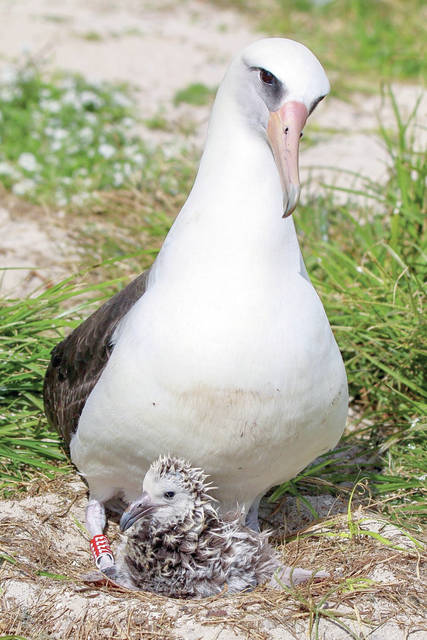PRINCEVILLE — There are still a few awkward young Laysan albatross wandering around Kauai with their wild feathers and wide wingspans, but Oahu’s albatross have all fledged and set record numbers while doing it.
The 2018 albatross nesting season closed at Kaena Point with 60 chicks fledging, up from 54 in 2015.
“We believe the increase is largely due to favorable environmental conditions, and that we have a lot of new breeders this year as a result of some of the earlier groups of chicks being old enough to breed,” said Lindsay Young, a researcher with Pacific Rim Conservation.
On Kauai, the state Department of Land and Natural Resources says there’s still a handful of hatchlings on private property and the Laysan albatross fledgling season continues.
Once they’ve fledged, juvenile Laysan albatross don’t return to the colony for three years after they’ve flown out to sea and don’t start breeding until they’re between five and eight years old.
When they do start breeding, they form bonded pairs that mate for life and generally have one egg annually, though albatross don’t always have a chick every year.
The chick grows under the care of both parents for about five months before it fledges out on its own.
The 2018 nesting season has hatched 87 chicks on Kauai’s Kilauea Point National Wildlife Refuge and so far 50 have fledged, with 17 still bobbing around their colony. The nest count was 161 nests, and that’s a 20 percent increase over the previous five-year average of 134 nests at KNPWR.
Further into the Papahanaumokukea Marine National Monument, the world’s oldest known bird, Wisdom, lost her chick this season while nesting on Midway Atoll.
“It was one of the approximately 25 percent of chicks that did not successfully fledge and leave the colony,” said Megan Nagel, with the U.S. Fish and Wildlife Service.
About 75 percent of eggs laid on Midway Atoll hatch annually and more than 70 percent of the entire Laysan albatross population depends on Midway Atoll, which is home to more than three million seabirds, including the largest colony of Laysan and black-footed albatrosses in the world.
“Wisdom has raised 36 chicks over her lifetime,” Nagel said. “Demonstrating that even one bird can make a significant contribution to the colony over the span of their lifetime.”
The 2017 breeding season closed with 56 chicks fledging from the refuge and in both years, pig predation has been a factor for the birds.
“This year, pigs breached our aging perimeter fence in multiple locations,” said Kim Uyehara, KNPWR refuge biologist. “The mortalities subsided after 11 pigs were removed.”
Currently, staff at KNPWR is working to upgrade the existing perimeter fence to reduce the need to continuously control introduced predators that prey on the ground-nesting native birds, manage invasive plants, and to improve habitat conditions.



Mahalo to JoAnn Yukimura for lining up the federal funds and negotiating the addition of two large pieces of land to refuge so today we have a strong return of our endemic birds. Most people don’t realize this is the results of her hard work. She collaborates well to produce excellent results like the refuge and when she collaborated with private tour bus companies to start the Kaua’i bus after Iniki so Kauaians could get around as many cars and homes were destroyed.
This article points up another reason to vote for JoAnn Yukimura for mayor. Added to her long list of previous accomplishments is the fact that she worked with the Kilauea community to protect Mokole’a Point and Crater Hill by adding those properties to the Kilauea Point National Wildlife Refuge.
JoAnn is HONEST — a characteristic that is above all else when I consider the candidates who will get my votes. My hope is that my fellow Kauaians see that as important as I do and that they will vote accordingly. JoAnn gets my vote.